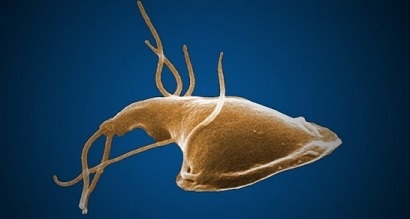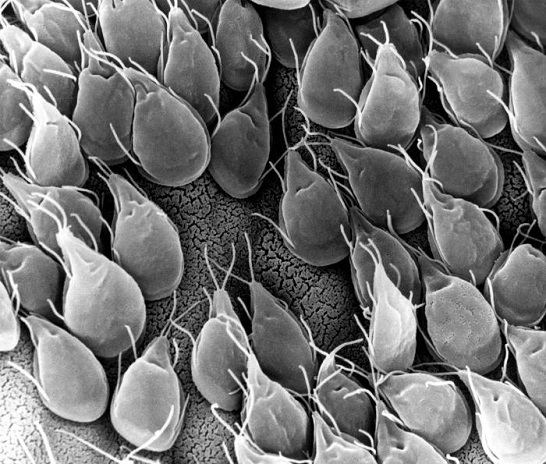GIARDIA (GIARDIASIS) TREATMENT FOR YOUR DOG, CAT AND GUINEA PIG.
What is Giardia?
Giardia is an infection of the gut caused by the Giardia parasite (see photo). These parasites settle in the gastrointestinal tract and often cause diarrhea or stools that are not compact or firm. A healthy pet with good natural resistance can be infected with Giardia without being noticed by the owner.
 |
Giardia was originally only found in areas with poor sanitation and where the water is not filtered enough. Unfortunately, this intestinal parasite is found almost everywhere in the world today.
Not so long ago, Giardia infections rarely occurred in Northern Europe/ USA. That is different nowadays. This is because we take our pets on holiday abroad, but also because many animals are imported from risk areas without having been previously examined for infectious diseases such as Giardia.
The Giardia infection is therefore the second most common parasitic infection today! The worm infection is still number one.
How does a dog or cat get infected with Giardia?
An animal can be infected by coming into contact with the feces of an infected animal, it is enough if the animal just sniffs the feces. This is probably the largest source of infection.
The development and life cycle of the Giardia parasite in your dog or cat.
If the parasite is not in a host's body, it is in a cyst. A cyst is a type of cocoon. Giardia parasites therefore enter the body of an animal as a cyst through the mouth. Then they go through the esophagus and stomach to the small intestine. When they arrive there, the cysts burst open, releasing the parasites. Then they multiply at a very high rate. The Giardia parasite has a type of suction cup with which it attaches itself to the intestinal wall. The intestinal wall becomes irritated and damaged. At some point, the parasite leaves the small intestine. In the last part of the intestines, the parasites turn back into a cyst. After that, the cysts are excreted with the feces. For the Giardia parasite, this means that he has to wait for a new host to appear.
The Giardia parasite can only survive outside a host's body if it is in a cyst. If cysts have left the host through feces, they are contagious for an average of another month. This is even longer in cold, damp weather.
Giardia symptoms in your dog or cat.
Young and weak animals infected with Giardia suffer usually from chronic diarrhea. The diarrhea can contain slime or even blood. It is also possible that the diarrhea may appear yellow or greasy. Infected animals usually have an appetite, but often lose weight. In some cases, animals suffer from sickness and vomiting.
However, no symptoms does not always mean that there is no Giardia infection. Healthy (adult) dogs and cats with good natural resistance rarely show symptoms when infected with Giardia. In other words, if your animal does not have diarrhea, this is not a sign that he does not have a Giardia infection!
It is a common misunderstanding that when treating Giardia, only animals with diarrhea need to be treated. Because of the very high risk of mutual contamination and re-contamination, all animals that live in groups must be treated.
 |
Giardia
If you suspect that your animal has Giardia, you should have the feces examined. If your animal shows symptoms of a Giardia infection, or you live in an area where several animals are infected with Giardia, it is best to have the feces examined for the presence of Giardia.
It is best to have the feces examined by your vet. He can determine if your dog or cat is infected with Giardia.
If the first test results are negative, this does not guarantee that your animal is not infected. In practice it often happens that there is an infection afterwards, although the test results do not indicate this. Do you suspect Giardia, but the first test is negative? Then, to be on the safe side, have the feces examined again after 14 days.
What is the treatment for Giardia with dogs and cats
The following points are important to treat a Giardia infection:
- hygiene measures; - adjustment of the nutrition; - treatment of the Giardia infection - parasites must be killed; - treatment and healing of the small intestines; - the animal's natural resistance must be increased.
Hygiene measures at Giardia
The hygiene measures below are essential when fighting Giardia.
Blankets, pillows and other things that your animal lies on should be washed as often and as hot as possible. The washing water must be at least 70 degrees Celsius, a lower temperature is not fatal for the Giardia cyst.
Water bowls, food bowls and litter boxes should be washed with boiling water every day. The toys should also be cleaned thoroughly and with hot water.
If you walk your dog, do this preferably in places where few other dogs come. Clear your dog's feces to reduce the risk of contamination for other animals. If your dog dropped feces during the walk, you can clean your dog's anus when you return home. Your dog can lick Giardia cysts from his anus during a wash and re-infect himself in this way. Cleaning the anus is best done with a disposable towel.
Remember that it is important to wash your own hands regularly.
Adjusting the food at Giardia in your dog or cat
The Giardia parasite thrives particularly well in the intestines of an animal that receives daily food containing carbohydrates. Therefore, make sure that your animal receives food that contains as few carbohydrates as possible during treatment against Giardia. A low-carbohydrate diet supports the process of "starving" Giardia.
It is best to feed your animal fresh meat or fish.
If it is not possible to feed fresh meat, good quality canned food without added grains is a very good alternative.
Treatment of Giardia in your dog or cat
A vet will usually prescribe antibiotic or dewormers with Giardia.
- Antibiotic has a very bitter taste, most animals only want to take this by force. Another disadvantage is the side effects that can occur. Antibiotic often only works temporarily, because it does not kill the parasite, it only inhibits its growth! - Dewormer has a temporary effect because it does not kill the parasite.
From the ancient Chinese philosophy of healing by the power of nature, the idea is that diseases, bacterial and parasitic infections can arise because a certain balance in the body is seriously disrupted. When this natural balance is restored, the body will restore itself. According to this Chinese philosophy, intestinal parasites are affected by an unhealthy lifestyle or other conditions that disrupt the intestines and the immune system. This makes the body susceptible to parasitic infections and unable to clean them up. In China, such ailments have long been successfully treated with supporting herbal remedies.
GIARDEX: HERBAL FORMULA FOR PETS WITH GIARDIA
Giardex consists of a carefully formulated mix of Chinese herbs. This herbal formula is suitable for dogs and cats with Giardia. The herbs in Giardex kill the parasites and their eggs. If the eggs die, the feces no longer pose a risk of infection to your own animal and other animals.
We recommend that you also give your animal Gastro and Immunity Complex.
It is important to properly care for and maintain the gastrointestinal tract of your animal. The gastrointestinal tract is the largest and most important immune organ in your animal's body. The Giardia parasite causes irritation and damage to the intestinal mucosa. Gastro stimulates the natural recovery of the intestinal mucosa and also promotes a better functioning of the intestines. Parasites more easily infect animals whose natural resistance is reduced. Immunity Complex promotes and supports both the immune and immune systems and also increases resistance. Giardia is considerably less likely to develop in animals with a healthy natural resistance and a well-functioning immune system.
In the customer comments you can read why other customers have bought Giardex and what their experiences with this formula are. The customer responses can be found at the very bottom of this text.
Orders placed before 2.30 pm and paid via PayPal will be shipped the same working day with track & trace.
 |
Giardex™, 90 tabl. 300 mg | € 24,10 |
 |
Giardex™, 180 tabl. 300 mg | € 45,80 |
 |
Giardex™, 90 tabl. 1200 mg | € 37,20 |
 |
Giardex™, 180 tabl. 1200 mg | € 71,10 |
Giardex= Trade mark
Giardex is a supplementary animal feed based on Chinese herbs. For dogs, cats, guinea pigs and other small pets of all ages, including puppies, kittens, pregnant and nursing pets. The herbs can be used over a longer period of time, there are no known side effects. The formula may be used together with medication from your vet, other Chinese herbs or homeopathy.
Composition Giardex: Polygala tenuifolia, Sophora flavescens, Notopterygium incisum, Phillodendron amurense, Ledebouriella divaricata, Dictamnus dasycarpus, Glycyrrhiza uralensis, Cnidium monnieri. Additive: Microcristalline cellulose, Crosslinked sodium carboxymethyl cellulose, Silicic acid. Analytical constituents: raw ash 3,1% crude fat 0,2% rough egg white 1,5% crude fiber 7,7% Natrium 0,3%.
Dosage: We advise to give a double dose during the first 14 days. You can also give the double dose for a longer period of time, if you find it necessary. With (sufficient) results, a normal dose can be given after 14 days.
|
|
||
|---|---|---|
| First 14 days | From 15 days | |
| 1 tabl. 300 mg 2x a day | ½ tabl. 300 mg 2x a day | |
| 2 tabl. 300 mg 2x a day | 1 tabl. 300 mg 2x a day | |
|
|
||
|---|---|---|
| First 14 days | From 15 days | |
| 1 tabl. 1200 mg 2x a day | ½ tabl. 1200 mg 2x a day | |
| 2 tabl. 1200 mg 2x a day | 1 tabl. 1200 mg 2x a day | |
| 3 tabl. 1200 mg 2x a day | 1½ tabl. 1200 mg 2x a day | |
| 4 tabl. 1200 mg 2x a day | 2 tabl. 1200 mg 2x a day | |
| 5 tabl. 1200 mg 2x a day | 2½ tabl. 1200 mg 2x a day | |
| 6 tabl. 1200 mg 2x a day | 3 tabl. 1200 mg 2x a day | |
For a guinea pig and rodent is relatively higher than the dosage for cats and dogs. Rodents are herbivores and therefore they need more herbs to get good results.
|
|
|
To administer: with a bit of cheese, meat etc., whatever the animal likes. It is possible to mix it with a bit of food, just make sure everything is eaten.
Result: the first improvements can be observed within 2 weeks. After 6 weeks, have Giardex examine your animal's feces. Giardia is very persistent and contagious. In connection with this, we advise to give Giardex at least 3 months according to the above dosing schedule.
Decreasing the dose: If the symptoms have disappeared for some time, you can stop Giardex. Once you have stopped using the Giardex, it is good to have the stool examined again after 6 to 8 weeks.
Maintenance dose: when your animal is healthy again, you can reduce the dose by 50%.
Preventive dose: 50% of the normal dose.
 |
 |
||




